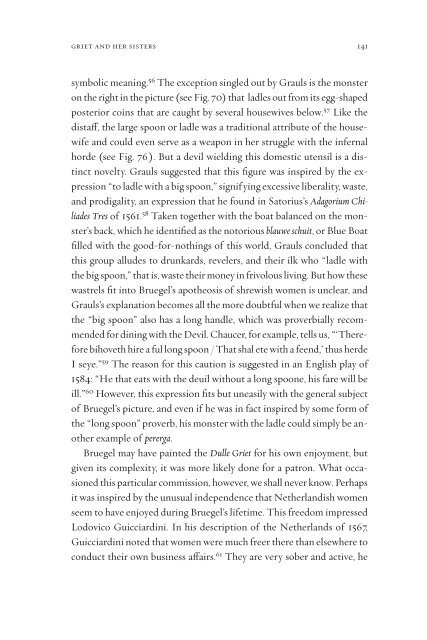Pieter Bruegel and the Art of Laughter - AAAARG.ORG
Pieter Bruegel and the Art of Laughter - AAAARG.ORG
Pieter Bruegel and the Art of Laughter - AAAARG.ORG
Create successful ePaper yourself
Turn your PDF publications into a flip-book with our unique Google optimized e-Paper software.
griet <strong>and</strong> her sisters 141<br />
symbolic meaning. 56 The exception singled out by Grauls is <strong>the</strong> monster<br />
on <strong>the</strong> right in <strong>the</strong> picture (see Fig. 70) that ladles out from its egg-shaped<br />
posterior coins that are caught by several housewives below. 57 Like <strong>the</strong><br />
distaª, <strong>the</strong> large spoon or ladle was a traditional attribute <strong>of</strong> <strong>the</strong> housewife<br />
<strong>and</strong> could even serve as a weapon in her struggle with <strong>the</strong> infernal<br />
horde (see Fig. 76 ). But a devil wielding this domestic utensil is a distinct<br />
novelty. Grauls suggested that this figure was inspired by <strong>the</strong> expression<br />
“to ladle with a big spoon,” signifying excessive liberality, waste,<br />
<strong>and</strong> prodigality, an expression that he found in Satorius’s Adagorium Chiliades<br />
Tres <strong>of</strong> 1561. 58 Taken toge<strong>the</strong>r with <strong>the</strong> boat balanced on <strong>the</strong> monster’s<br />
back, which he identified as <strong>the</strong> notorious blauwe schuit, or Blue Boat<br />
filled with <strong>the</strong> good-for-nothings <strong>of</strong> this world, Grauls concluded that<br />
this group alludes to drunkards, revelers, <strong>and</strong> <strong>the</strong>ir ilk who “ladle with<br />
<strong>the</strong> big spoon,” that is, waste <strong>the</strong>ir money in frivolous living. But how <strong>the</strong>se<br />
wastrels fit into <strong>Bruegel</strong>’s apo<strong>the</strong>osis <strong>of</strong> shrewish women is unclear, <strong>and</strong><br />
Grauls’s explanation becomes all <strong>the</strong> more doubtful when we realize that<br />
<strong>the</strong> “big spoon” also has a long h<strong>and</strong>le, which was proverbially recommended<br />
for dining with <strong>the</strong> Devil. Chaucer, for example, tells us, “‘Therefore<br />
bihoveth hire a ful long spoon / That shal ete with a feend,’ thus herde<br />
I seye.” 59 The reason for this caution is suggested in an English play <strong>of</strong><br />
1584: “He that eats with <strong>the</strong> deuil without a long spoone, his fare will be<br />
ill.” 60 However, this expression fits but uneasily with <strong>the</strong> general subject<br />
<strong>of</strong> <strong>Bruegel</strong>’s picture, <strong>and</strong> even if he was in fact inspired by some form <strong>of</strong><br />
<strong>the</strong> “long spoon” proverb, his monster with <strong>the</strong> ladle could simply be ano<strong>the</strong>r<br />
example <strong>of</strong> pererga.<br />
<strong>Bruegel</strong> may have painted <strong>the</strong> Dulle Griet for his own enjoyment, but<br />
given its complexity, it was more likely done for a patron. What occasioned<br />
this particular commission, however, we shall never know. Perhaps<br />
it was inspired by <strong>the</strong> unusual independence that Ne<strong>the</strong>rl<strong>and</strong>ish women<br />
seem to have enjoyed during <strong>Bruegel</strong>’s lifetime. This freedom impressed<br />
Lodovico Guicciardini. In his description <strong>of</strong> <strong>the</strong> Ne<strong>the</strong>rl<strong>and</strong>s <strong>of</strong> 1567,<br />
Guicciardini noted that women were much freer <strong>the</strong>re than elsewhere to<br />
conduct <strong>the</strong>ir own business aªairs. 61 They are very sober <strong>and</strong> active, he












